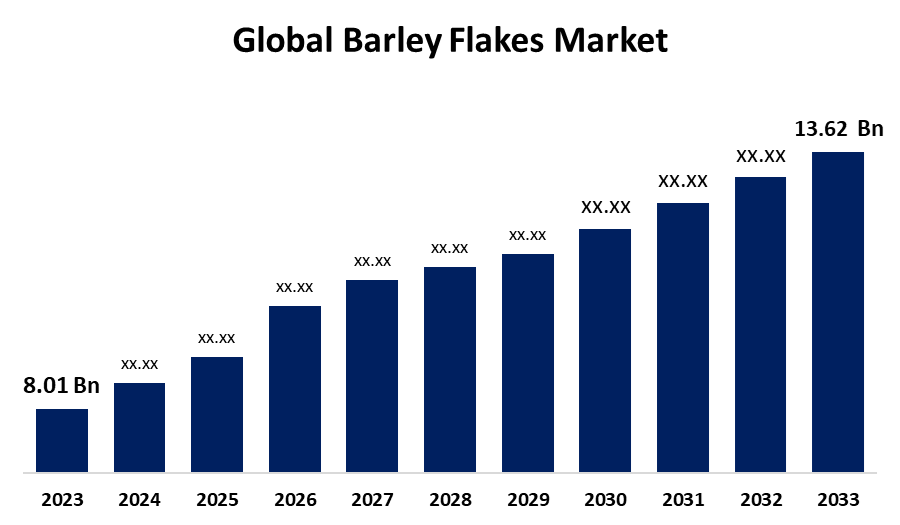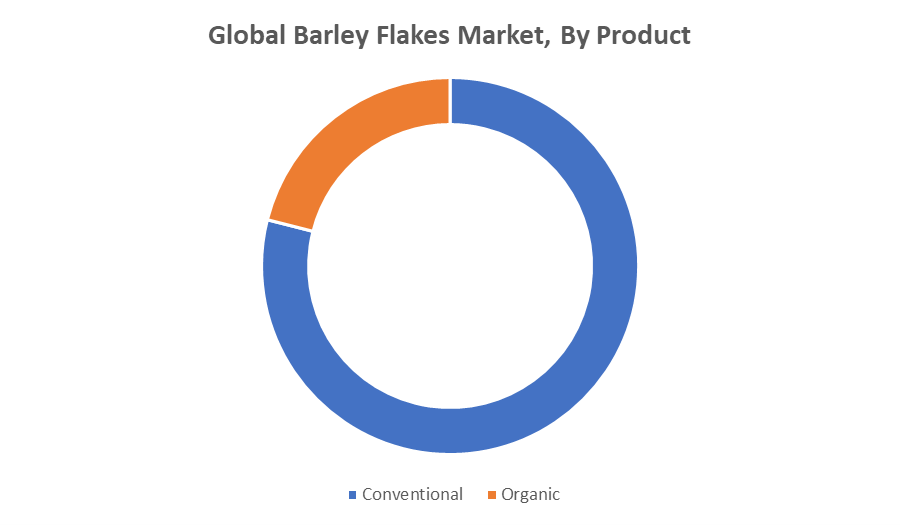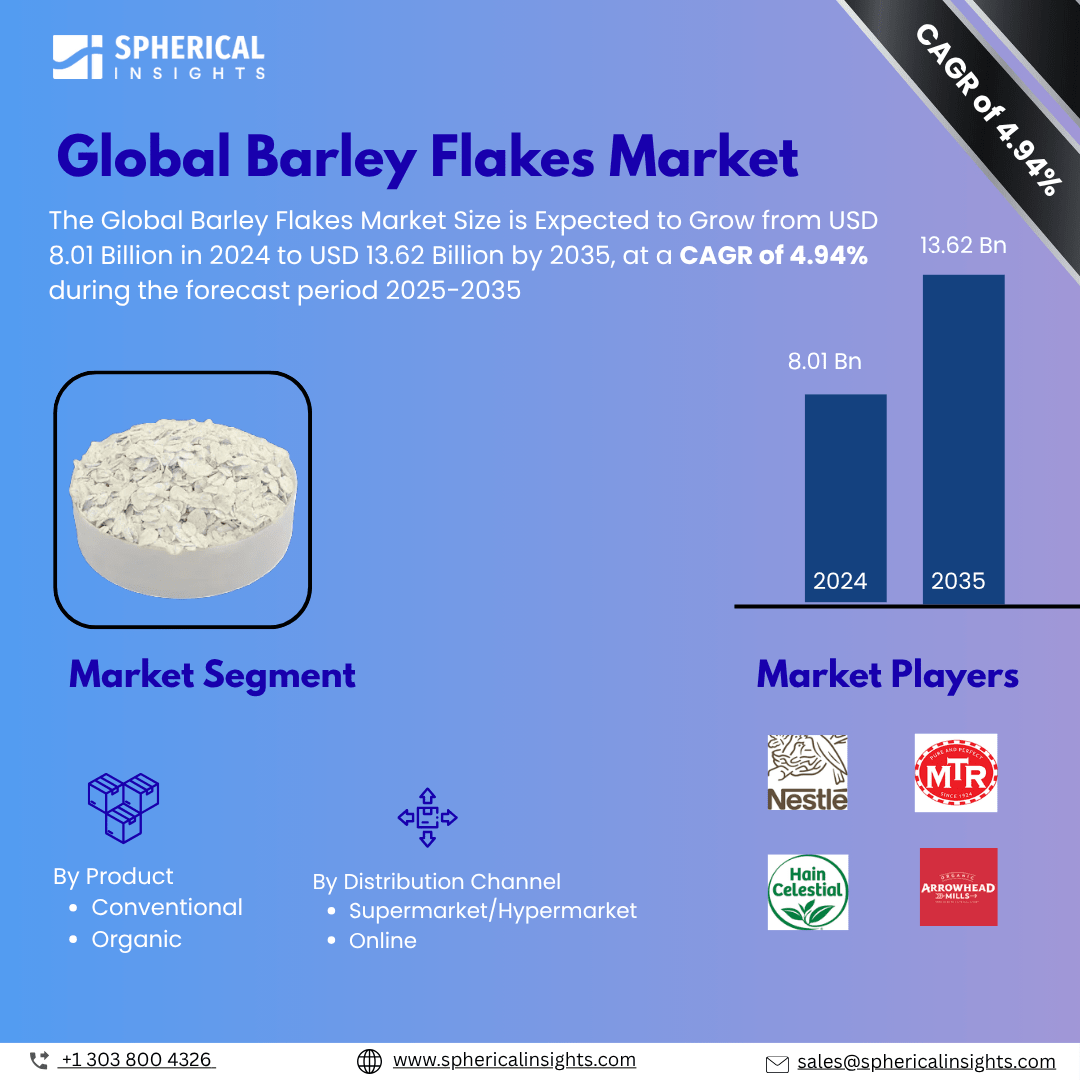Global Barley Flakes Market Insights Forecasts To 2035
- The Global Barley Flakes Market Size Was Estimated at USD 8.01 Billion in 2024
- The Market Size is Expected to Grow at a CAGR of around 4.94% from 2025 to 2035
- The Worldwide Barley Flakes Market Size is Expected to Reach USD 13.62 Billion by 2035
- Asia Pacific is expected to Grow the fastest during the forecast period.

Barley Flakes Market
The barley flakes market involves the production and distribution of steamed and rolled barley grains commonly used in various food and beverage applications. Barley flakes retain much of the grain’s natural fiber, vitamins, and minerals, making them a nutritious ingredient in products such as breakfast cereals, granola bars, baked goods, and soups. The market is segmented by type, including organic and conventional barley flakes, with the conventional segment currently holding the majority share. In terms of distribution channels, supermarkets and hypermarkets lead sales, though online retail is experiencing rapid growth due to increasing digital adoption. The food and beverage industry represents the largest end-use sector, with demand rising due to consumer interest in healthy and minimally processed ingredients.
Attractive Opportunities in the Barley Flakes Market
- Developing flavored, fortified, or vitamin-enriched barley flakes presents a strong opportunity to appeal to specific consumer groups such as children, seniors, and health-focused adults. Innovations like gluten-free, high-protein, or low-sugar versions can help barley flakes compete more directly with mainstream breakfast and snack products.
- Barley requires less water and fewer chemicals to cultivate compared to many other grains, making it a more sustainable crop. Positioning barley flakes as an eco-friendly, low-impact food can appeal to environmentally conscious consumers and boost brand loyalty.
Global Barley Flakes Market Dynamics
DRIVER: Increasing popularity of plant-based and whole-grain diets
Rising consumer awareness about health and nutrition is a major contributor, as barley flakes are high in dietary fiber, vitamins, and minerals, making them an appealing choice for health-conscious individuals. The increasing popularity of plant-based and whole-grain diets has further boosted demand, as barley flakes serve as a nutritious alternative to more processed grains. Busy lifestyles are also encouraging the consumption of convenient, ready-to-eat or easy-to-prepare foods, where barley flakes fit well in breakfast cereals, granola bars, and meal kits. In addition, food manufacturers are innovating with flavored, organic, and gluten-free barley flake products to cater to diverse dietary preferences. The clean-label trend, which emphasizes natural and minimally processed ingredients, is another driver supporting market expansion. Growing applications in not only food and beverages but also in animal feed and cosmetics add to the increasing global demand for barley flakes.
RESTRAINT: Low consumer awareness and familiarity with barley flakes
One of the main challenges is the low consumer awareness and familiarity with barley flakes compared to more popular grains like oats, corn, or wheat. Many people are still unaware of the nutritional benefits of barley, which affects its adoption in everyday diets. Additionally, barley flakes face strong competition from other well-established breakfast and snack options, making it harder to gain market share. Production costs can also be relatively high, especially due to variable barley yields and supply chain issues, which can lead to higher prices for consumers. Moreover, inconsistent quality standards and food regulations across different countries can make it difficult for manufacturers to expand into new markets. These factors, combined with limited product variety and marketing, restrict the wider acceptance and growth potential of barley flakes in both developed and developing regions.
OPPORTUNITY: Growing interest in foods that offer extra health benefits
The barley flakes market has many opportunities to grow. One chance is to create new and exciting products, like flavored or vitamin-enriched barley flakes, that can attract different groups of people, such as kids or older adults. There is also a growing interest in foods that offer extra health benefits, so barley flakes with added nutrients could become popular. Restaurants and cafes are looking for new, healthy ingredients, which gives barley flakes a place to shine. Because barley uses less water and fewer chemicals to grow, it can appeal to people who care about the environment. In countries where cities are growing and modern stores are opening, barley flakes can find new customers. Lastly, working with fitness experts and popular food services can help more people learn about barley flakes and include them in their diets.
CHALLENGES: Limited shelf life of barley flakes compared to other grains
One major issue is the limited shelf life of barley flakes compared to other grains, which can lead to storage and transportation difficulties, especially in warmer climates. Another challenge is the variability in barley quality due to differences in farming practices and climate conditions, which affects the consistency of the final product. Processing barley flakes also requires specialized equipment and expertise, which can increase production costs for manufacturers. Additionally, consumer taste preferences often favor sweeter or more familiar grains, making it harder for barley flakes to become a staple. Marketing barley flakes effectively is challenging because it requires educating consumers about their unique benefits, which demands time and investment. Finally, the fluctuating prices of raw barley on global markets can create uncertainty for producers and sellers, making long-term planning difficult and affecting market stability.
Global Barley Flakes Market Ecosystem Analysis
The global barley flakes market ecosystem includes barley farmers, processors, equipment manufacturers, distributors, and retailers. Farmers grow barley, which processors turn into flakes through steaming and rolling. Equipment makers supply the machinery needed for production. Distributors and wholesalers deliver products to supermarkets, online stores, and other retail channels. Consumers include households and food manufacturers using barley flakes in cereals, snacks, and baked goods. Regulatory bodies ensure quality and safety, while research institutions drive innovation. Marketing agencies and retailers help raise awareness, making the ecosystem interconnected and essential for the market’s growth.
Based on the product, the conventional segment dominated the global market, with the largest revenue share over the forecast period

Conventional barley is widely grown using traditional agricultural practices, which ensures a steady supply and consistent quality of raw materials. This availability helps keep prices relatively lower compared to organic or specialty barley flakes, making conventional products more accessible to a broader range of consumers. Additionally, consumer familiarity and trust in conventional barley flakes contribute to their strong market position. Many manufacturers and retailers focus on conventional barley flakes due to the larger demand, which reinforces its dominance. While the organic segment is growing due to rising health and environmental concerns, conventional barley flakes continue to account for the largest revenue share because they are more affordable, widely distributed, and readily incorporated into various food products like cereals, baked goods, and snacks.
Based on the distribution channel, the supermarket/hypermarket segment dominated the market with the largest revenue share over the forecast period

The supermarket and hypermarket segment has dominated the barley flakes market, capturing the largest revenue share over the forecast period. This dominance is largely due to the extensive reach and wide consumer base these retail formats offer. Supermarkets and hypermarkets provide convenient one-stop shopping experiences, making them preferred destinations for consumers purchasing everyday staples like barley flakes. They also offer greater product variety and competitive pricing, which attracts a diverse range of buyers. Additionally, supermarkets and hypermarkets have strong supply chain networks that ensure consistent availability of barley flakes, boosting sales. While online retail and specialty stores are growing, the supermarket/hypermarket segment remains the key driver of barley flakes distribution, contributing significantly to the overall market revenue.
Europe is anticipated to hold the largest market share of the barley flakes market during the forecast period
Europe is anticipated to hold the largest market share of the barley flakes market during the forecast period. This is due to the region’s well-established health-conscious consumer base, high demand for whole grains, and strong preference for nutritious and functional foods. Additionally, Europe’s advanced agricultural infrastructure supports consistent barley production, ensuring a steady supply of raw materials. The presence of major food manufacturers and extensive retail networks, including supermarkets and health food stores, further drives market growth. Moreover, increasing awareness about the benefits of barley flakes in promoting digestive health and managing chronic diseases contributes to their rising popularity. These factors combined position Europe as the leading region in the global barley flakes market throughout the forecast period.
Asia Pacific is expected to grow at the fastest CAGR in the barley flakes market during the forecast period
Asia Pacific is expected to grow at the fastest CAGR in the barley flakes market during the forecast period. This rapid growth is driven by rising health awareness among consumers, increasing disposable incomes, and expanding urbanization in countries like China, India, and Japan. The growing popularity of Western diets and a shift towards healthier, whole-grain alternatives are also fueling demand. Additionally, the development of modern retail infrastructure, including supermarkets and online stores, makes barley flakes more accessible to a wider audience. Rising interest in plant-based and functional foods further supports market expansion in the region, positioning Asia Pacific as the fastest-growing market for barley flakes globally.
Key Market Players
KEY PLAYERS IN THE BARLEY FLAKES MARKET INCLUDE
- The Quaker Oats Company
- Nestlé S.A.
- PepsiCo, Inc. (Quaker Foods Division)
- MTR Foods Pvt Ltd
- Hain Celestial Group, Inc.
- Arrowhead Mills, Inc.
- Grain Millers, Inc.
- Rude Health Ltd.
- Cosmic Nutracos Solutions Pvt. Ltd. (Gaia brand)
- Bobs Red Mill Natural Foods, Inc.
- Others
Market Segment
This study forecasts revenue at global, regional, and country levels from 2020 to 2035. Spherical Insights has segmented the barley flakes market based on the below-mentioned segments:
Global Barley Flakes Market, By Product
Global Barley Flakes Market, By Distribution Channel
- Supermarket/Hypermarket
- Online
Global Barley Flakes Market, By Regional Analysis
- North America
- Europe
- Germany
- UK
- France
- Italy
- Spain
- Russia
- Rest of Europe
- Asia Pacific
- China
- Japan
- India
- South Korea
- Australia
- Rest of Asia Pacific
- South America
- Brazil
- Argentina
- Rest of South America
- Middle East & Africa
- UAE
- Saudi Arabia
- Qatar
- South Africa
- Rest of the Middle East & Africa






